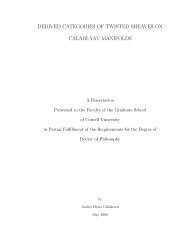FIVE MAJOR RESULTS IN ANALYSIS AND TOPOLOGY Aaron ...
FIVE MAJOR RESULTS IN ANALYSIS AND TOPOLOGY Aaron ...
FIVE MAJOR RESULTS IN ANALYSIS AND TOPOLOGY Aaron ...
Create successful ePaper yourself
Turn your PDF publications into a flip-book with our unique Google optimized e-Paper software.
CHAPTER 3<br />
The Stone-Weierstrass Theorem<br />
One of the most important structures studied in mathematical analysis is the set C(X,Y )<br />
of all continuous functions from a compact space X (such as [0, 1]) into a metric space Y<br />
(such as R or C). An understanding of this set is crucial for the development of modern<br />
and classical calculus, differential equation theory, differential geometry, and several other<br />
branches of mathematics. For many applications in classical analysis, X is taken to be a<br />
closed interval of the real line, and Y is taken to be either C or, as a special case, R. One<br />
particular subset of C([0, 1], C) - the class of all complex polynomials on [0, 1] - is particularly<br />
easy to study. Karl Weierstrass showed that, in the metric space (C([0, 1], C),ρ∞), for any<br />
function f and any ǫ > 0, one can find a polynomial p such that ρ∞(f,p) < ǫ. This result is<br />
known as the Weierstrass approximation theorem. There are two widely known constructive<br />
proofs of this theorem. The version presented here uses a set of polynomials known as<br />
the Landau kernels, and follows that given in [12]. The other proof uses the Bernstein<br />
polynomials, and can be found in [13].<br />
Theorem (Weierstrass). Let f be a continuous complex-valued function on [a,b]. Then<br />
there exists a sequence of polynomials Pn such that Pn(x) → f(x) uniformly on [a,b]. If f<br />
is real, then the Pn can be taken to be real.<br />
Proof. Without loss of generality, assume that [a,b] = [0, 1], and that f(0) = f(1) = 0.<br />
Furthermore, define f(x) to be zero for every x /∈ [0, 1]. Then f is uniformly continuous on<br />
the entire real line. Let Qn(x) = cn(1 − x 2 ) n for each n ∈ N, where cn is chosen to ensure<br />
15
















